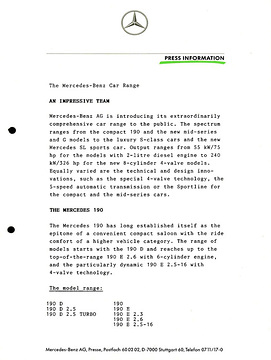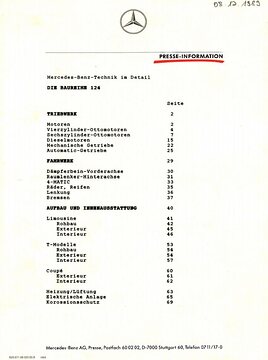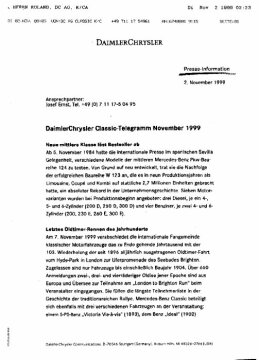Delete
Do you really want to delete the data record?
Download
Please wait a moment ...
Download
Please wait a moment ...
Download
Please wait a moment ...
Crop for shopping cart
Please wait a moment ...
Set as main picture
Do you want to set this media object as main picture?
-
Caption
:
Pressemappe. AAA Berlin 06.10. - 16.10.1988: Daimler-Benz auf der AAA ‘88. Tradition und Fortschritt; Wesentliche Merkmale der Mercedes-Benz-Design-Philosophie. Funktion und Markenidentität; Der Modelljahrgang 1989 des Mercedes-Benz 190 im Überblick. Feinschliff und ein Kraftpaket; Achtzylinder mit 5,6 Liter Hubraum auch als Mercedes-Benz 560 SE. Jenseits gewohnter Dimensionen; Daimler-Benz erweitert Benziner-Palette um 200 E und TE. Einspritzer für Einsteiger; Mercedes-Benz 250 D TURBO: Noch ein Kraft-Diesel für die Mittlere Klasse. Bestechende Dynamik; Techn. Daten Mercedes-Benz-Pkw-Programm; Daimler-Benz in Berlin; Daimler-Benz Heute
-
Pages
:
32
-
Caption
:
Pressemappe. MBE + Zeiss Veranstaltung: Das Pkw-Programm der Mercedes-Benz AG. Ein starker Auftritt; Vielseitige Sterne aus Bremen. Mercedes-Benz-T-Reihe 200 TD - 300 TE 4MATIC; 4MATIC von Mercedes-Benz. Automatisch schaltender Vierradantrieb für die Typen 300 D 4MATIC, 260 E 4MATIC, 300 D TURBO 4MATIC, 300 E 4MATIC, 300 TD TURBO 4MATIC, 300 TE 4MATIC; Eine konsequente Lösung für Gelände und Straße. Mercedes-Benz Geländewagen; Die Mercedes-Benz AG. Jüngstes und zugleich traditionsreichstes deutsches Automobilunternehmen
-
Pages
:
46
-
Caption
:
Press Kit. MBE + Zeiss Veranstaltung: The Mercedes-Benz Car Range. An impressive team; The versatile stars from Bremen. Mercedes-Benz T Series 200 TD - 300 TE 4MATIC; Mercedes-Benz 4MATIC. Automatically engaging four-wheel drive for 300 D 4MATIC, 260 E 4MATIC, 300 D TURBO 4MATIC, 300 E 4MATIC, 300 TD TURBO 4MATIC, 300 TE 4MATIC; Convincing solution for operation on and off the road. Mercedes-Benz Cross-Country Vehicle; Mercedes-Benz AG. Germany’s newest vehicle manufacturer with the longest tradition
-
Pages
:
44
-
Caption
:
Pressemappe. Die Baureihe 124: Mercedes-Benz-Technik im Detail. Die Baureihe 124; Triebwerk: Motoren, Vierzylinder-Ottomotoren, Sechszylinder-Ottomotoren, Dieselmotoren, Mechanische Getriebe, Automatic-Getriebe; Fahrwerk: Dämpferbein-Vorderachse, Raunlenker-Hinterachse, 4-MATIC, Räder, Reifen, Lenkung, Bremsen; Aufbau und Innenausstattung: Limousine: Rohbau, Exterieur, Interieur; T-Modelle: Rohbau, Exterieur, Interieur; Coupé: Exterieur, Interieur, Heizung/Lüftung, Elektrische Anlage, Korossionsschutz
-
Pages
:
70

Loading







